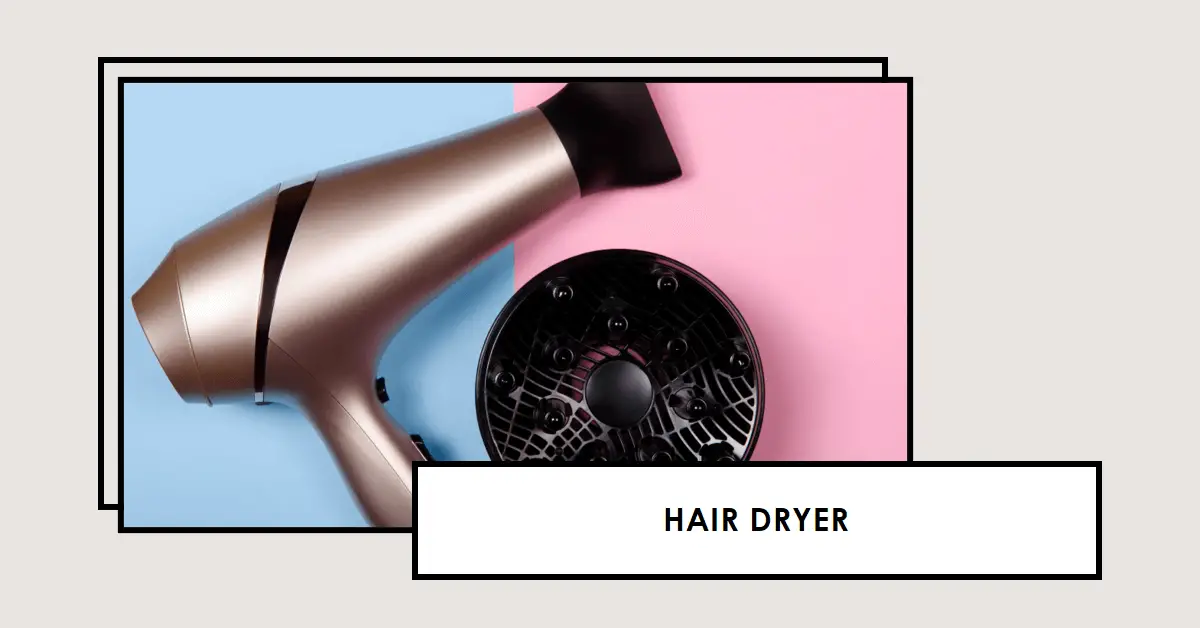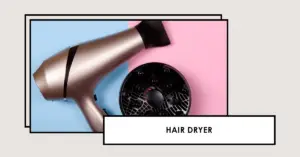Image: “Article Feature Image” by Bing, Source: [Bing Graphic Art].
We all love the convenience of hair dryers for quick and efficient hair drying. But have you ever wondered what could happen if your trusty hair dryer accidentally gets wet? Well, it’s essential to know the potential risks and how to handle such a situation to ensure your safety and the longevity of your hair dryer.
When a hair dryer comes into contact with water, it poses significant risks due to the combination of electricity and moisture. Using a wet hair dryer is dangerous and can lead to electric shock, fire hazards, and damage to the appliance.
In this guide, we’ll walk you through the possible dangers, step-by-step solutions, and some preventive measures to keep in mind. So, let’s dive in!
How Hair Dryers Work
Before we delve into the risks, let’s quickly understand how a hair dryer works. A hairdryer consists of several components, including a heating element and a fan.
When you turn it on, electricity powers the heating element, which warms up the air. The fan then blows this warm air onto your hair, helping to evaporate moisture and dry your locks quickly.
Potential Dangers of Getting a Hair Dryer Wet
Accidents can happen to anyone, and getting your hair dryer wet is one such mishap that requires attention. Here’s what you need to be aware of:
Electrical Hazards: A wet hair dryer poses a significant electrical hazard. Water is an excellent conductor of electricity, and if it comes into contact with the live electrical components inside the dryer, it can lead to a short circuit or cause damage to the appliance.
Risk of Electric Shock: If you touch a wet hair dryer while it’s plugged in, you could be at risk of electric shock. Even if the outer surface is damp, it’s better to be cautious and avoid touching it until you’ve taken proper safety measures.
Fire Hazard: In extreme cases, water getting inside the hair dryer can lead to a fire hazard. Water coming into contact with the hot heating element can cause sparks or even ignite a fire, putting you and your surroundings in danger.
Damage to Hair Dryer Components: Water can also cause damage to the internal components of the hair dryer, leading to malfunctions and reducing its lifespan.
What to Do If Your Hair Dryer Gets Wet
Stay calm, and don’t panic if your hair dryer accidentally gets wet. Follow these simple steps to handle the situation safely:
Immediate Actions
- Unplug the Hair Dryer: If the hair dryer is plugged in, immediately unplug it from the electrical outlet to eliminate the risk of electric shock.
- Remove from Water: If the hair dryer has fallen into water or any liquid, carefully remove it from the liquid without touching the appliance’s electrical components.
Safety Precautions
- Do Not Use While Wet: Never use a hair dryer that has gotten wet, even if you’ve dried the external surfaces. Wait until you’ve thoroughly dried all internal components.
- Don’t Force Dry: Avoid using a hair dryer to force-dry the internal parts. This might cause more harm and can be dangerous.
Testing for Safe Operation
- Patience is Key: Allow the hair dryer to air dry for at least 24-48 hours before attempting to use it again.
- Silica Gel or Rice: If you have access to silica gel packets or rice, place the hair dryer in a sealed bag along with them. These materials can help absorb moisture effectively.
Read also my article: The Hidden Dangers of Plugged-in Hair Dryers!
Steps to Dry a Wet Hair Dryer Safely
Follow these steps to ensure your hair dryer is safe to use after it has gotten wet:
- Unplugging the Hair Dryer: Double-check that the hair dryer is unplugged from the electrical outlet.
- Drying External Surfaces: Use a clean, dry cloth to gently wipe off any visible water from the external surfaces of the hair dryer.
- Drying Internal Components: To dry the internal components, gently shake the hair dryer to remove any excess water. Then, leave it in a well-ventilated area to air dry thoroughly.
- Using Silica Gel or Rice for Absorption: If possible, place the hair dryer in a sealed bag along with silica gel packets or rice to aid in moisture absorption.
Signs of Damage to a Hair Dryer
It’s crucial to be vigilant and look for signs of damage to ensure your hair dryer is safe to use:
- Visible Damage: Check for any visible signs of damage, such as frayed wires or burnt areas. If you notice anything unusual, do not use the hair dryer and consider seeking professional assistance.
- Unusual Smells or Noises: If the hair dryer emits strange smells or makes unusual noises when turned on, it might indicate water damage or internal issues.
- Tripping Circuit Breakers: If the hair dryer repeatedly trips the circuit breaker or blows fuses, it’s a red flag indicating a potential problem.
Risks of Using a Wet Hair Dryer
Using a wet hair dryer can lead to various risks:
- Impact on Hair Health: Applying a wet hair dryer to your hair can cause damage, including frizziness, split ends, and reduced shine.
- Increased Electrical Risks: Operating a wet hair dryer increases the likelihood of electric shock or a short circuit.
- Voiding Warranty and Insurance Coverage: Attempting to use a wet hair dryer could void the warranty or insurance coverage, leaving you with additional expenses if it needs repairs or replacement.
Preventive Measures to Avoid Water Damage
Prevention is always better than dealing with the aftermath of a mishap. Here are some preventive measures to keep your hair dryer safe from water damage:
- Safe Operating Practices: Always handle your hair dryer with dry hands and avoid using it near water sources.
- Keeping Hair Dryers Away from Water Sources: Store your hair dryer in a dry and safe location, away from sinks, bathtubs, or open water containers.
- Storing Hair Dryers Properly: When not in use, store your hair dryer in a dry and clean place.
Safe Alternatives for Drying Hair
While waiting for your hair dryer to dry, here are some safe alternatives for drying your hair:
- Towel Drying: Gently pat your hair with a clean, dry towel to remove excess moisture.
- Air Drying: Letting your hair dry naturally is a safe option, especially on warmer days.
- Low Heat Settings: If your hair dryer has adjustable heat settings, use the lowest heat setting to minimize potential damage.
FAQs about Hair Dryer Safety
Can I use a hair dryer in the bathroom?
It’s best to avoid using a hair dryer in the bathroom, especially if the bathroom is small and lacks proper ventilation. Moisture from showers can create a humid environment, increasing the risk of accidents.
Can I use a hair dryer near a sink?
No, it’s not safe to use a hair dryer near a sink or any other water source. Keep your hair dryer away from water to prevent accidents.
What should I do if my hair dryer falls into the water?
If your hair dryer falls into water, unplug it immediately and follow the steps outlined earlier in this guide to dry it safely. Do not attempt to use it until you’re certain it’s thoroughly dry.
How often should I clean my hair dryer?
Regularly clean the external surfaces of your hair dryer with a soft, dry cloth to remove dust and debris. Keeping it clean will help maintain its performance and longevity.
Conclusion
Knowing what to do if your hair dryer gets wet is essential for your safety and the well-being of your appliance.
Remember, water and electricity don’t mix well, so always unplug your hair dryer if it comes into contact with any liquid.
By following the steps we’ve outlined in this guide and adopting preventive measures, you can ensure your hair dryer remains in top-notch condition and keep your hair styling routine safe and enjoyable. Stay safe and style responsibly!
Want to learn more about electricity? Check my YouTube channel!
Are You An Electrical Engineer or Electrician?
Install my Free On Google Play Now! It’s 100% Free
The staff I recommend (Amazon Affiliate Links to products I believe are high quality):
- Economy 120 Volt/60Hz AC Power Source – Step-Down Voltage & Frequency Converters 1800W
- UNI-T Digital Multimeter Tester UT139C
- 50-Amp Extension Cord for RV “100ft”
- Voltage Stabilizer 110/220v
- Hair Dryer “best selling“
- TOSHIBA EM131A5C-BS Countertop Microwave Ovens
Disclaimer: This contains affiliate links to Amazon products. I may earn a commission for purchases made through these links.

